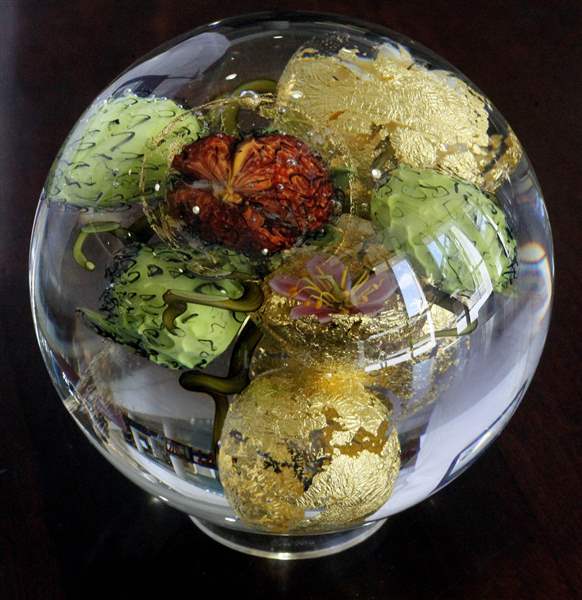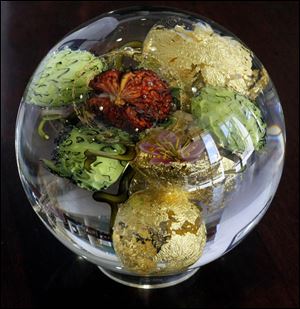
'Outsider' Paul Stankard's work in hot demand
6/15/2012
An orb donated by Paul Stankard to be auctioned.
The Blade/Amy E. Voigt
Buy This Image

Glass artist Paul Stankard, 69, speaks about his life's work Thursday at SeaGate Convention Centre as part of the Glass Art Society conference.
During the heady early years of studio glass in the 1960s through the 1980s, artists invented processes, tools, and formulas for creating art glass, and museums bought this new medium.
Paul Stankard was on a different track, one that wasn't always appreciated by the glass pioneers. He notes that the new Color Ignited: 1962-2012 exhibit at the Toledo Museum of Art includes work by most everybody who's made it big in the last 50 years, but nothing by him.
Stankard, 69, spoke Thursday about his life's work to 75 people at SeaGate Convention Centre as part of the Glass Art Society conference continuing through Saturday.
"I'm a bit of an outsider. There's a bit of bias," he said in an interview with The Blade over coffee after his talk. Harvey Littleton, nicknamed the father of American studio glass, disparaged the process Stankard uses, called flameworking, in a public talk, Stankard said. Littleton, who started the first U.S. glass program at the University of Wisconsin in the early 1960s, blew glass. There were also biases against flowers, paperweights, and people who didn't go to college, he said.
But, added the cheerful white-bearded Stankard, you can't argue with excellence.
READ MORE about the 2012 Glass Art Society Conference at toledoblade.com/glassarts.
His highly collectible orbs, cubes, and columns hark to 1840s France and are made in part by melting thin glass rods in a flame at a table. He manipulates hot strands into tiny petals, leaves, anthers, and stamens, then forms them into a flower. When an assemblage of flowers, perhaps with a bee or a blueberry, looks right, he'll encase it in glass. Over the years, his pieces have evolved in complexity, with honeycombs, damselflies, mountain laurel, masks, and even miniscule human forms curved into "roots."
He finds inspiration in nature's glory, quoting Walt Whitman: "The morning glory by my window satisfies me more than the metaphysics of books."
During his talk he often searched for the right word. Stankard's challenges surpass not being part of studio glass's in-crowd. Unable to read, write, or spell well, he believed he was stupid until his late 20s when he learned about dyslexia. "Until then, I couldn't prove I wasn't [stupid]."
Writing his life story, No Green Berries or Leaves: The Creative Journey of an Artist in Glass (2007), would have been impossible without computer programs. In addition, his wife, Pat, read drafts, and his brother Robert read it aloud to Stankard, cajoling him to shorten rambling sentences. It was a five-year effort.
He also suffered from agoraphobia, panic attacks, and a nervous breakdown in 1976 due to several factors, not the least of which was that both his father and father-in-law were dying and he took on much of their care. "The beautiful thing about phobias is, you can get over them," he said.

An orb donated by Paul Stankard to be auctioned.
Following high school, he studied scientific glass-blowing at a vocational school, but failed his first year and would have been kicked out had he not begged for another chance. He found work making glass tubing, vials, coils, and vessels for use by scientists and industry, mastering several techniques.
At home, he made glass animals and pennies in tiny bottles. And when he read a 1965 article about paperweights, he was determined to make them.
In 1972, he tossed blueprints and his $10,500 annual salary to get creative. It was a risk: He and Pat had four children. He made $6,400 the first year; $7,200 the second, and in the third, hired an assistant.
The father of five employs a few assistants (including offspring) and a manager at his New Jersey studio, teaches at the vocational school he attended, and is an informal teacher to 3,000 "friends" on Facebook. He's searching for one more frontier.
"I want to develop a new body of work, more spiritual," he says. "I've been experimenting for two months" encasing glass flowers in orbs he paints with gold leaf, encapsulating several orbs in glass. He donated one to the conference's Saturday auction: as he unwrapped the four-inch paperweight from a hotel towel and showed it to a few admirers Thursday, renowned glass artist Toots Zynsky (who has several pieces in the museum's Color Ignited show), feigned slipping it into her handbag.
Indeed, times have changed for Stankard. These days his exquisite objects range in price from $6,500 to $75,000.
Contact Tahree Lane at tlane@theblade.com or 419-724-6075.